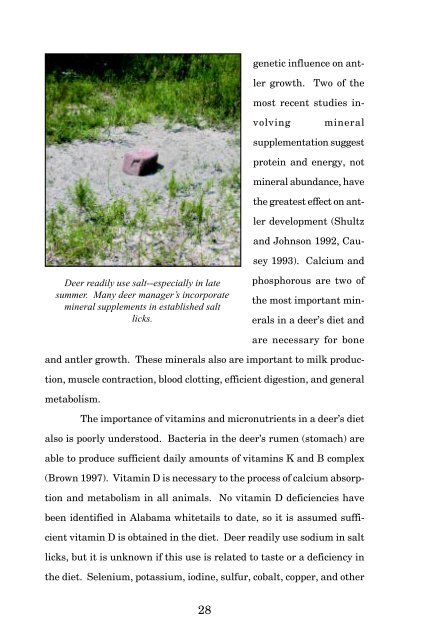Biology And Management Of White-tailed Deer In Alabama
Biology And Management Of White-tailed Deer In Alabama
Biology And Management Of White-tailed Deer In Alabama
Create successful ePaper yourself
Turn your PDF publications into a flip-book with our unique Google optimized e-Paper software.
genetic influence on antler<br />
growth. Two of the<br />
most recent studies involving<br />
mineral<br />
supplementation suggest<br />
protein and energy, not<br />
mineral abundance, have<br />
the greatest effect on antler<br />
development (Shultz<br />
and Johnson 1992, Causey<br />
1993). Calcium and<br />
<strong>Deer</strong> readily use salt--especially in late<br />
summer. Many deer manager’s incorporate<br />
mineral supplements in established salt<br />
licks.<br />
phosphorous are two of<br />
the most important minerals<br />
in a deer’s diet and<br />
are necessary for bone<br />
and antler growth. These minerals also are important to milk production,<br />
muscle contraction, blood clotting, efficient digestion, and general<br />
metabolism.<br />
The importance of vitamins and micronutrients in a deer’s diet<br />
also is poorly understood. Bacteria in the deer’s rumen (stomach) are<br />
able to produce sufficient daily amounts of vitamins K and B complex<br />
(Brown 1997). Vitamin D is necessary to the process of calcium absorption<br />
and metabolism in all animals. No vitamin D deficiencies have<br />
been identified in <strong>Alabama</strong> whitetails to date, so it is assumed sufficient<br />
vitamin D is obtained in the diet. <strong>Deer</strong> readily use sodium in salt<br />
licks, but it is unknown if this use is related to taste or a deficiency in<br />
the diet. Selenium, potassium, iodine, sulfur, cobalt, copper, and other<br />
28
















